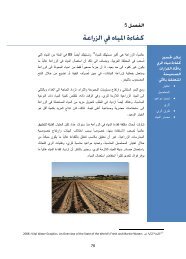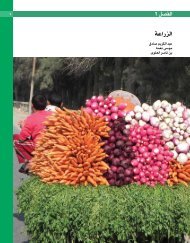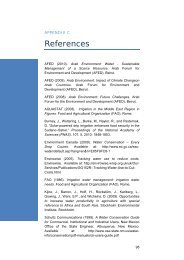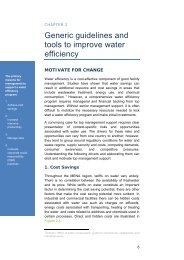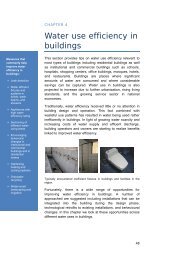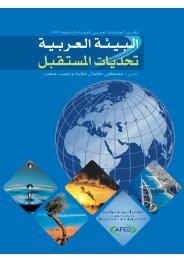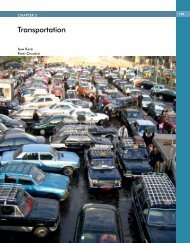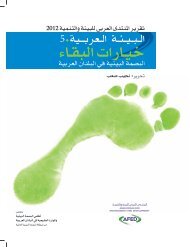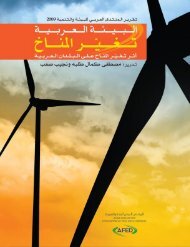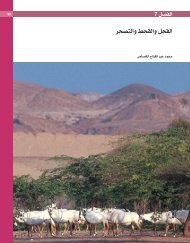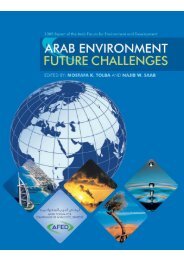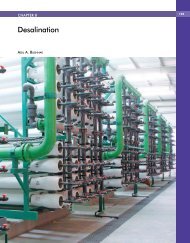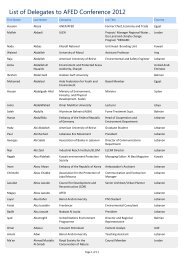Impact of Climate Change on Arab Countries - (IPCC) - Working ...
Impact of Climate Change on Arab Countries - (IPCC) - Working ...
Impact of Climate Change on Arab Countries - (IPCC) - Working ...
You also want an ePaper? Increase the reach of your titles
YUMPU automatically turns print PDFs into web optimized ePapers that Google loves.
64<br />
CHAPTER 5<br />
FOOD PRODUCTION<br />
I. INTRODUCTION<br />
Food security in the <strong>Arab</strong> world has experienced<br />
a l<strong>on</strong>g history <str<strong>on</strong>g>of</str<strong>on</strong>g> envir<strong>on</strong>mental and socio-ec<strong>on</strong>omic<br />
pressures. The dominant arid c<strong>on</strong>diti<strong>on</strong>s,<br />
limited water resources, erratic cropping patterns,<br />
low knowledge and technology levels are<br />
the main factors presently affecting food producti<strong>on</strong><br />
systems in the <strong>Arab</strong> world.<br />
Most recent assessments have c<strong>on</strong>cluded that arid<br />
and semi-arid regi<strong>on</strong>s are highly vulnerable to climate<br />
change (<strong>IPCC</strong>, 2007a). On the other hand,<br />
at a high level c<strong>on</strong>ference <str<strong>on</strong>g>of</str<strong>on</strong>g> the Food and<br />
Agriculture Organizati<strong>on</strong> (FAO) held in Rome in<br />
June 2008, the delegates asserted that agriculture<br />
is not <strong>on</strong>ly a fundamental human activity at risk<br />
from climate change, it is a major driver <str<strong>on</strong>g>of</str<strong>on</strong>g> envir<strong>on</strong>mental<br />
and climate change itself. The projected<br />
climatic changes will be am<strong>on</strong>g the most<br />
important challenges for agriculture in the twenty-first<br />
century, especially for developing countries<br />
and arid regi<strong>on</strong>s (<strong>IPCC</strong>, 2007a).<br />
By the end <str<strong>on</strong>g>of</str<strong>on</strong>g> the 21 st century, the <strong>Arab</strong> regi<strong>on</strong><br />
will face an increase <str<strong>on</strong>g>of</str<strong>on</strong>g> 2 to 5.5 º C in the surface<br />
temperature. This increase will be coupled with a<br />
projected decrease in precipitati<strong>on</strong> up to 20%.<br />
These projected changes will lead to shorter winters<br />
and dryer summers, hotter summers, more<br />
frequent heat wave occurrence, and more variability<br />
and extreme weather events occurrence<br />
(<strong>IPCC</strong>, 2007b).<br />
II. KEY IMPACTS AND VULNERABILITIES<br />
OF THE AGRICULTURE SECTOR IN THE<br />
ARAB WORLD<br />
The risks associated with agriculture and climate<br />
change arise out <str<strong>on</strong>g>of</str<strong>on</strong>g> str<strong>on</strong>g complicated relati<strong>on</strong>ships<br />
between agriculture and the climate system,<br />
plus the high reliance <str<strong>on</strong>g>of</str<strong>on</strong>g> agriculture <strong>on</strong> finite natural<br />
resources (Abou-Hadid, 2009). The interannual,<br />
m<strong>on</strong>thly and daily distributi<strong>on</strong> <str<strong>on</strong>g>of</str<strong>on</strong>g> climate<br />
variables (e.g., temperature, radiati<strong>on</strong>, precipitati<strong>on</strong>,<br />
water vapour pressure in the air and wind<br />
speed) affects a number <str<strong>on</strong>g>of</str<strong>on</strong>g> physical, chemical and<br />
biological processes that drive the productivity <str<strong>on</strong>g>of</str<strong>on</strong>g><br />
agricultural, forestry and fisheries systems (<strong>IPCC</strong>,<br />
2007a). In the cases <str<strong>on</strong>g>of</str<strong>on</strong>g> forestry and fisheries systems,<br />
vulnerability depends <strong>on</strong> exposure and sensitivity<br />
to climate c<strong>on</strong>diti<strong>on</strong>s, and <strong>on</strong> the capacity<br />
to cope with changing c<strong>on</strong>diti<strong>on</strong>s.<br />
The current total cultivated area in the <strong>Arab</strong><br />
regi<strong>on</strong> makes up about 5% <str<strong>on</strong>g>of</str<strong>on</strong>g> the total global cultivated<br />
area, and it represents about 5% <str<strong>on</strong>g>of</str<strong>on</strong>g> the<br />
total area <str<strong>on</strong>g>of</str<strong>on</strong>g> <strong>Arab</strong> world (FAO, 2008b). Most <str<strong>on</strong>g>of</str<strong>on</strong>g><br />
the <strong>Arab</strong> regi<strong>on</strong>’s lands are classified as hyperarid,<br />
semi-arid and arid land z<strong>on</strong>es (WRI, 2002).<br />
The relati<strong>on</strong>ship between the cultivated area and<br />
the populati<strong>on</strong> is <strong>on</strong>e <str<strong>on</strong>g>of</str<strong>on</strong>g> the major challenges facing<br />
food producti<strong>on</strong> in the regi<strong>on</strong>. The land<br />
share per capita is decreasing annually as a result<br />
<str<strong>on</strong>g>of</str<strong>on</strong>g> rapid populati<strong>on</strong> growth rates and urbanizati<strong>on</strong><br />
(AOAD, 2008). By 2007, the average agricultural<br />
land share in the <strong>Arab</strong> regi<strong>on</strong> was about<br />
0.23 ha per capita, which is slightly lower than<br />
the world average <str<strong>on</strong>g>of</str<strong>on</strong>g> 0.24 ha per capita.<br />
The dominant agricultural system in <strong>Arab</strong> countries<br />
is rainfed agriculture; the total irrigated area<br />
in the <strong>Arab</strong> world is less than 28% (FAO,<br />
2008b). Therefore, annual agricultural productivity<br />
and food security are highly correlated to<br />
the annual variability <str<strong>on</strong>g>of</str<strong>on</strong>g> precipitati<strong>on</strong>, which has<br />
exhibited major changes in recent decades<br />
(Abou-Hadid, 2006). Irrigated agriculture is<br />
widely represented in the <strong>Arab</strong>ian Peninsula<br />
countries and Egypt, where fully irrigated agriculture<br />
makes up 100% and 95% <str<strong>on</strong>g>of</str<strong>on</strong>g> the total cultivated<br />
area, respectively.<br />
The agricultural productivity <str<strong>on</strong>g>of</str<strong>on</strong>g> most crops<br />
exhibited noticeable increases during recent<br />
years. The per capita food producti<strong>on</strong> index<br />
(PCFPI) shows the food output, excluding animal<br />
feed, <str<strong>on</strong>g>of</str<strong>on</strong>g> a country’s agriculture sector relative<br />
to the base period 1999-2001 (FAO, 2008b).<br />
The PCFPI value <str<strong>on</strong>g>of</str<strong>on</strong>g> the <strong>Arab</strong> regi<strong>on</strong> increased<br />
from 99.8 in 2003 to 112.3 by 2005, an increase<br />
<str<strong>on</strong>g>of</str<strong>on</strong>g> 13%, whereas the world values <str<strong>on</strong>g>of</str<strong>on</strong>g> the PCFPI<br />
increased during the same years by 20% (AOAD,<br />
2008). The productivities <str<strong>on</strong>g>of</str<strong>on</strong>g> crops under irrigated<br />
agriculture in the <strong>Arab</strong> regi<strong>on</strong> improved due<br />
to switching to new cultivars, applying modern<br />
technologies and improving management programs;<br />
to yield some <str<strong>on</strong>g>of</str<strong>on</strong>g> the highest productivities<br />
all over the world in some <strong>Arab</strong> countries, such as<br />
in Egypt and Sudan. On the other hand, the<br />
majority <str<strong>on</strong>g>of</str<strong>on</strong>g> <strong>Arab</strong> countries have serious problems<br />
in agricultural producti<strong>on</strong> as a result <str<strong>on</strong>g>of</str<strong>on</strong>g> limited<br />
ec<strong>on</strong>omic resources, low levels <str<strong>on</strong>g>of</str<strong>on</strong>g> technology,<br />
limited crop patterns, and envir<strong>on</strong>mental limitati<strong>on</strong>s<br />
and pressures (Agoumi, 2001).



